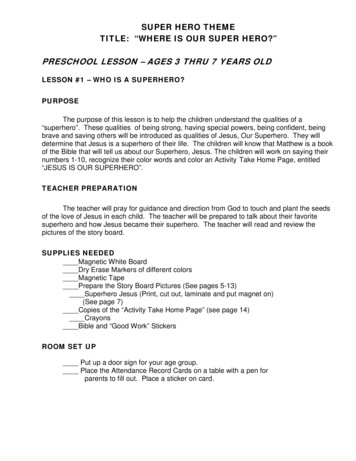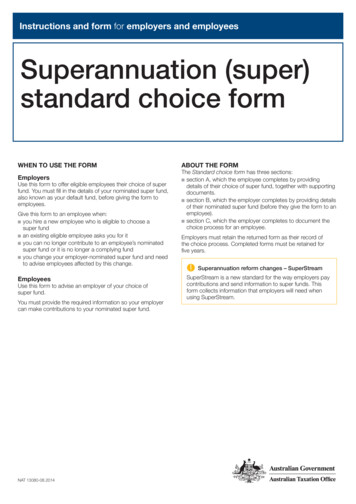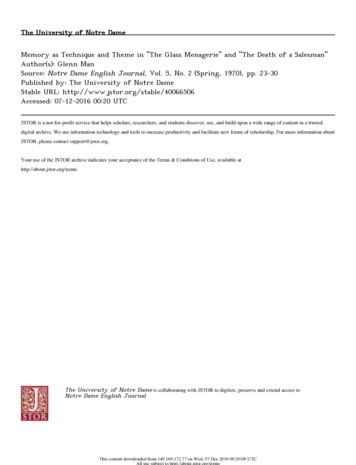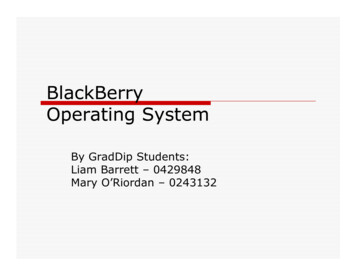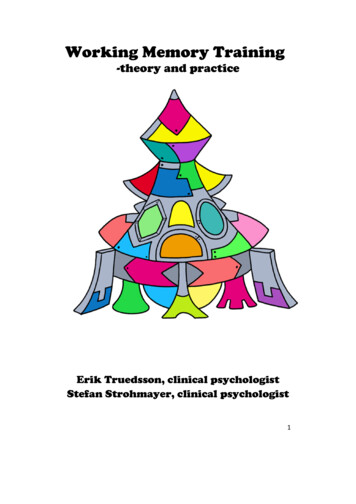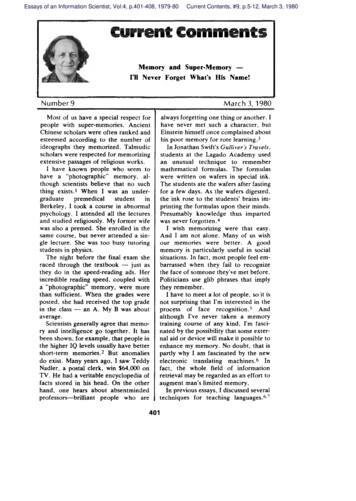
Transcription
Essays of an Information Scientist, Vol:4, p.401-408, 1979-80Current Contents, #9, p.5-12, March 3, 1980CurremtGammentsMemoryI’ll NeverNumber9andForgetSuper-MemoryWhat’s—His Name!MarchMost of us have a special respect forpeople with super-memories.AncientChinese schoIars were often ranked andesteemed according to the number ofidiographsthey memorized.Talmudicscholars were respected for memorizingextensive passages of religious works.I have known people who seem tohave a “photographic”memory,although scientists believe that no suchthing exists. 1 When I was an undergraduatepremedicalstudentinBerkeley, I took a course in abnormalpsychology. I attended all the lecturesand studied religiously. My former wifewas also a premed. She enrolled in thesame course, but never attended a single lecture. She was too busy tutoringstudents in physics.The night before the final exam sheraced through the textbook — just asthey do in the speed-readingads. Herincredible readhtg speed, coupled witha “photographic”memory, were morethan sufficient. When the grades wereposted, she had received the top gradein the class — an A. My B was aboutaverage.Scientists generally agree that memory and intelligence go together. It hasbeen shown, for example, that people inthe higher IQ levels usually have bettershort-termmemories.2But anomaliesdo exist. Many years ago, I saw TeddyNadler, a postal clerk, win 64,000 onTV. He had a veritable encyclopedia offacts stored in his head. On the otherhand, one hears about absentmindedprofessors—brilliantpeople who are4013,1980always forgetting one thing or another. Ihave never met such a character,butEinstein himself once complained abouthis poor memory for rote learning. sIn Jonathan Swift’s Gulliveri Tra vets,students at the Lagado Academy usedan unusualtechniqueto remembermathematicalformulas. The formulaswere written on wafers in special ink.The students ate the wafers after fastingfor a few days. As the wafers digested,the ink rose to the students’ brains imprinting the formulas upon their minds.Presumablyknowledgethus impartedwas never forgotten.4I wish memorizingwere that easy.And I am not alone. Many of us wishour memorieswere better.A goodmemory is particularlyuseful in socialsituations. In fact, most people feel embarrassed when they fail to recognizethe face of someone they’ve met before.Politicians use glib phrases that implythey remember.I have to meet a lot of people, so it isnot surprising that I’m interested in theprocessof face recognition. Andalthough I’ve never taken a memorytraining course of any kind, I’m fascinated by the possibility that some external aid or device will make it possible toenhance my memory. No doubt, that ispartly why I am fascinated by the newelectronictranslatingmachines. Infact, the whole field of informationretrieval may be regarded as an effort toaugment man’s limited memory.In previous essays, I discussed severaltechniquesfor teachinglanguages. b7
—a memory training course by mall. ‘l’hecourse, entitled How to Build MemorySkills, is aimed at the business executiveand contains variations of mnemonictechniquesfoundin thepopularliterature.It is offeredas part ofAMAEI’scorrespondencecurriculumin businessmanagement.But thememorycourse can be orderedindependentlyof the curriculum for 65from American ManagementAssociation, 135 West 50th Street, New York,NY 10020.1A huge amount of informationisstored in our memory. It is sometimesdifficult to retrieve the precise information that we want at a particular time.Unless you use certain information frequently you may need a little help. Onereason mnemonic systems work is thatthey provide the appropriate “cues” tostimulate proper recall. 18 We’ve all experienced the phenomenon of not beingable to say that which is right “on the tipof the tongue. ” Then after a few seconds someone says something that triggers your recall.Susan D, Miller, an associate professor who teaches acting at the University of Illinois in LJrbana, says that manyactorsuse self-learned“associativedevices” to help them remember theirlines. These devices are unique to eachactor. But Miller says that novice actorscan help themselvesif they performtheir onstage gestures while studyingtheir lines. “The activity, ” says Miller,“helps to reinforcewhat the line isabout. “19 But it was difficult to find anydocumentedaccount of how actors aretaught to memorize per se. Repetitionseems to be the rule for actors as well asfor musicians.Frances A. Yates of the Warburg Institute, University of London, wrote aclassic study of the history of memoryThe Art of Memory. () Thetechniques,ancient Greek poet Simonides is credited with developing what became knownas the loci system of recall, the earliestNot all of those techniques were effective. If I had a few of Swift’s memorywafers, I’d write whole vocabularies andgrammars on them. Lacking the wafers,I decided to examine both the popularliteratureand some scientific studiesabout memory training. I hoped to findsome technique that would help the student of foreign languages learn fasterwithout endless repetition.One road to memory improvement involves the use of mnemonic devices. Amnemonic, as defined in Webster’s, issimply anything“intendedto assistmemory. ” The word is derived fromwhichmeanstheGreekmneme,“memory. ”Theelementaryschoolchant “Thirty days bath September. .“is a mnemonicthat helps Englishspeaking people remember how manydays are in each month.There are many different kinds ofmnemonics. Whole systems of memorytraining have been built around some ofthem. Popular books have been writtenon the subject of memory improvement. For example, Bruno Furst published his Memory Power Made Easy in1952.9 Many more popular books havebeen published since thenl{}lq that profess to teach one how to rememberanything, be it a shopping list, sometelephone numbers, or the 50 states inalphabeticalorder. Formal courses inmemory training are not normally offered as part of a college curriculum.But since 1973, Kenneth L, Higbee hasbeen giving such a course at BrighamYoung University. Is In it he teaches avariety of mnemonic systems, includingall of those discussed in this essay. TheNew School for Social Research, NewYork City, also offers a course inmemory training. A recent article inQuesr/80 identified several other placeswhere one can receive memory training.Most of them are in the New York Cityarea.l The American Management Association Extension Institute (AMAEI) offers402
known form of mnemonic training. Inthe loci system, one imagines a familiarbuilding, possibly one’s own house. Tomemorize a sequence of ideas, as in aspeech, each idea is visually associatedwith a part of the house. The first ideamay be associated with the front door,the second idea with the foyer, and soon until the final idea is associated withthe back door. aoTo give a modem example of how thesystem works, suppose you were givinga speech on the future of scientificresearch. Your speech includes a capsule history of how science has advanced since Newton. You might imagine a picture of an apple tree hanging onthe front door, since a falling apple supposedly inspiredNewton’s work ongravity. If your speech ends with theassertionthat the future of sciencedependson continuedgovernmentfunding of basic research,you mightimagine a test tube filled with money sitting on a table near the back door. Toremember all the parts of the speech,you simply take a mental tour of thehouse, “seeing” each idea in succession.The ancient Greeks used the locisystem as an aid to rhetoriciansforremembering points to be made in longspeeches. But the system may have applications to other memory problems. Arecent study by researchersat OhioUniversity showed that college studentseasily remembereda sequenceof 20randomly selected words using placeson campus as the loci.21 One can imagine using thk system to remember errands to run or a series of appointments.But obviously, there are a number ofmemoryproblemswe face daily towhich the loci system cannot be applied. One of these problems is connecting a person’s face with hk or her name.More about that later.Another memory techniquein frequent use today is called the first-lettermnemonic.Unlike the loci system, itdoes not employ visual imagery. In-403stead, the first letters of the items to berememberedare made to form a meaningful sentence. Thus the phrase EveryGood Boy Deserves Favor reminds usthat the lines of a musical staff arecalled E, G, B, D, and F. Similarly,RichardOf YorkGaveBattleIn Vain,or RO Y, Go Bn”ng In Violet, reminds usthat the colors of the visible spectrumare red, orange, yellow, green, blue, indigo, and violet. Presumably,one canmake up a first-lettermnemonictoremember just about anything. A studyat the University College of Swansea(UK) showed that first-letter systems arethe mnemonic devices most frequentlyused by college students studying forfinal exams.zzBut the system has its limitations.Petet E. Morris of the University ofLancaster, who has authored a numberof articles on memory, observes thatfirst-lettermnemonicsare effectivewhen the items to be rememberedarewell-known and only their order is atissue. They are not very effective forhelping to remembernew words orideasthatareunfamiliarto theleamer.23Morrisnotes that, until recently,psychologistspaid scant attentiontomnemonics.“The dominationof thebehaviounstphilosophy,”he writes,“whichmaintainedthatstatementsabout mental events were unscientific,discouragedseriousstudyof themnemonics.”lsThisexplainswhypopular authors have virtually monopolized the subject for so long. But duringthe past inmnemonictechniques.A number ofstudies have been performed to test theeffectivenessof the memory systemsexpoundedin thepopularliterature.zl -z7 And it now appears thatmnemonictechniqueswhich employvisual imagery, such as the [oci system,are more effective than those which donot. 24
Nearly all of the popular books onmemory improvement make use of visual imagery. In one book, Memory MadeRobertMontgomeryemploysEasy,what is known as a “peg” system. 10Before learning how to make the visualassociations. the reader is urged to learnthe peg words by reciting the followingchant: “One, bun; two. glue: three, key:four, store; five, drive; six, mix: seven,oven: eight, bait; nine, dine; ten, hen. ”youhavea list of tenNovJ supposethings to remember. Whatever the firstitem is, you imagine yourself biting intoa hamburger bun to find the item thereinstead of the burger. To remember thesecond object,you imagine yourselfpouring glue all over it and becomingstuck to it. To remember the third item,you imagine yourself unlocking a closetdoor and having hundreds of that itemtumble down upon you. And so onthrough the list of ten.One advantage of this system is thatonce you learn the peg words, you canrecall the ten items out of sequence ifyou want to. If the same pegs are usedmanyover and over again to rememberlists of things, will there be interferencefrom past associationswith the samepegs? The answer is, probably not.Peter E. Morris and R.L. Reid performed an experiment in which subjectsmemorized several lists of words using apeg system similar to the one describedhere. The lists each contained the samewords but in different orders. The subjects performedthe memorizationfarbetter than a control group and, whenquestioned, reported no interference inlearning each list . Perhaps the most famous Americanauthorof memorybooks is HarryLorayne.He has appearedoften ontelevision performing fantastic feats ofmemory. Lorayne has written How toDevelopa Super-PowerMemory,t Theand RememberingPeople. t Lorayne uses a visual systemcalled the “link. ” It’s a methodofremembering a series of things by link-MemoryBook, (I404ing themvisualtogetherthroughassociations.Lorayne writes that if visual imageryis good, then strong visual imagery mustbe better. Therefore, the visual imagesthe readers are told to see are exaggerated and sometimes grotesque. Suppose you want to remembera list ofwords, The first word is airplane. Thesecond w )rd is tree. AccordingtoLorayne, it does no good to imagine anairplane parked next to a tree. That inl age is to{) plausible. Better to imaginetrees boarding airplaneslike passengers. 13 (p. 10) The next word on the listis envelope.Youshouldimagineyourself trying to stuff a tree info anenvelope. You have now }isually linkedwordsthreetogether.Youcanpresumably link together a list of anysize, The very act of forming theassociationsand visually linking themtogether forces you to concentrateonthe items t{) be remembered,This inpart explains why the link is supposed t ]work.One corollaryto any mnemtmicsystem is that words which c:ln’t bevisuali7.ed must he changed to w nxis[hat can. Suppose vou wanted to mem(vri7,e the 50 states in alphabetical order.You cannot picture “Alabama,”butchanging that to “album” will give you aconcrete image. For Alaska, it is suggested that you visualize the dessert“baked Alaska. ” To start the link, youcan imagine an album serving bakedAlaska to other albums.Other books make use of the linksystem, including Montgomery’s Mcvl )r.v Made Easy. 1‘)f-orayne”s The Mem or.vBook is of particular interest because itcovers the learningof foreign languages, The techniqueused here iscalled “paired association. ” It operateson the same principles as the link, except that it is not used to remember longchains of items. The French word forthe noun “duck” is canard, This istranslated into can hard. To rememberthat canard means duck, you imagine
someone throwing a can at you hard,and you duck to avoid it. The Frenchword for bread is pain, pronounced“pan.” It is suggested that you imaginethe handle of a frying pan to be a loaf ofFrench bread. 13Michael R. Raugh and Richard C. Atkinson of StanfordUniversityhaveshown the system to be an effective aidto acquiring a foreign vocabulary .zbz”In one of their studies, they gave a list ofSpanish words to two groups of undergraduates. One group was instructed onthe use of paired association. As a control, the other group was not. When thetwo groups were tested for vocabularyrecall, the mnemonic group scored anaverage of 88%, while the control groupscored 28%. 27Lorayne and other authors of popularmemory books apply their techniques toconnecting names with faces. Supposeyou meet someone named Andrea Sheldon. You might convert the name to“hand-dryer shell-on.” Now suppose themost distinguishingfeature of AndreaSheldon’s face is her large, bulging eyes.You might picture her eyes to be seashells bulging from her head while she isusing a hand-dryeron her hair, Thepoint is to change a person’s name tosomething that can be visualized, and toassociate that visualization to a prominent part of the person’s appearance. 1 Several authors of memory books alsopropose a system for remembering numbers by substituting a consonant soundforeach digit: l Tand D; 2 N; 3 M:4 R; 5 L; 6 J, Sh, and Ch; 7 K, C,and G: 8 F, V, and Ph; 9 P and B;O Z and S. Vowel sounds signifynothing. Once one has learned whichconsonant sound goes with each digit,sentences can be formed to remembernumbers. Thus, the sentence “Everyoneloves to sing” suggests the number8,425,801,027 .10111sMorns observes that the link system isindeed effective, although there is noevidence that bizarre imagery works anybetter than normal pictures. 18 lS1s’sTom Di Julia tried the link system andreports some success. He was able toremembersome of the exercise listspresented in the books. He was evenwell on his way to memorizing the SOstates in alphabetical order, but gave upthe project because of the sheer time involved in forming the images and linking them together.For all the effectivenessof thepopular mnemonicsystems describedhere, they fall short of the claims oftheir authors. Lorayne and the othersassert that their techniquescan beadapted to all situations. Once you ha emastered these systems, the spiel goes,there’s no reason why you should forgetanything. But in order to employ thesememory systems, you must first beaware that something is worthy of remembrance. For example, seeing an automobile parked in the street is a verysmall event in your life. You thinknothing of it. But suppose you laterlearn that the parked auto you saw wasinvolved in a crime. Could you describethe auto in detail to the police? Couldyou recall the license number? In otherwords, mastery of these techniques doesnot confer automatic total recall, as thefront matter on a number of popularbooks imply.Such automatic total recall would require a photographicmemory, if such athing existed.With a photographicmemory, a person would be ab[e to“briefly look at materials, including pictures and printed matter, and to recallthem as visual images. ”1 This memory“snapshot” would last long enough forthe person to recall details some timelater.Psychologists have studied the possibilitythatphotographicmemoryexists. z In their investigations,theyfound that some people do retain visualimages after taking a brief look at anitem. However, the images are retainedfor only a short time, lasting from a fewseconds to a few minutes. This type ofmemory,iseideticrecall,called405
given a marginally observed phenomenon, those who wished to see it, did;and those who doubted it saw too muchinconsistency to become convinced.”jzBut in a review article, S.R. Mitchelland colleaguesat the UniversityofAlabamasuggest a reason why theBabich results were so hard to reproduce.jj They note that at the time of theBabich paper, it was widely assumedthat RNA was involved in memory storage. Researchers began using ever morehighly purified RNA extracts from ratbrains for their memory-transferexperiments. But as Mitchell reports, mostresearchers who failed to achieve resultsused higher concentrationsof RNA,while those who were “ignorant of theprevailing dogma” used cruder preparations and achievedpositiveresults.Mitchell supportsG. Ungar’s theorythat it is through peptides, the constituent parts of proteins, that memory canbe transferredfrom one animal toanother. It will be interesting to watch futuredevelopmentsin this line of research.Incidentally,about five years ago 1S1’sA.E. Cawkell produced a selected bibliography of the most significant paperson memory transfer up to that time.j The bibliographywas developedtodemonstratehow the Science CitationIndex’T(SCF’ ) can be an effectivesearch tool even in the hands of someone with no prior knowledge of a givensubject.More promising than memory transfer is the current research into drugsthat may enhance memory, particularlyin the elderly. One drug under study isPiracetam,an anti-vertigo compound.In 1976, Per Mindus of Karolinska Hospital, Stockholm,tested the drug onelderly patientswho complainedofmemory impairment. J He found thatpatientswho took Piracetamscoredhigher on learning and memory teststhan those who took a placebo. Mindusacknowledges,however, that the effectof the drug on some patients was small.reportedly found in no more than 5 to10’%oof children and is even rarer inadolescents. z It is true that subjectswho are shown many pictures in quicksuccession can recognize them again ata later time. But they are not able toreconstructthe picture in every detailwithin their own minds.zq There is nodoubt that some people do have superior memories. Anecdotal evidence supports this contention. 1.29 Nevertheless,psychologistsconcludethatsuperpower memories differ from “normal”memories in degree only, not in kind.z Several developments within the neuroscienceover the past two decadesmay ultimately lead to the best memory“techniques”of all. In 1965, F.R.Babichandcolleaguesat UCLApublished a paper in Science that was totouch off a lively controversyamongneuroscientist.They trained rats to approach a food dish at the sound of aclick. Then they extracted brain matterfrom these trained rats and injected itinto untrained rats. The untrained ratsshowed a marked tendency to approachthe food dish at the sound of the click,even though no food was there. )As far back as 1957, this “transfer ofmemory” phenomenonhad been demonstrated in planarians, simple animalswith rudimentarynervous systems .31But the discovery that memory can betransferredin rats, animals of muchgreater complexity, caused excitementwithin the scientific community.The Babich paper was not the first toreport such results in rats, but it received wide attention. A number of researchersset out to reproducetheBabich findings, but the results weremixed. Although many researchers confirmed the transfer of memory phenomenon, many others failed to achievepositive results. It was this failure toconsistently achieve positive results thateventually discredited the whole line ofresearch.Louis Neal Irwin, of theShriver Center for Mental Retardation,wrote: “In retrospect, it seems clear that406
Very little is known about how the brainprocesses and stores information.Andwe must be cautious about forming conclusions, since research into memorydrugs is new. The results of this researchare not unequivocal,and negative results do appearin the literature. 1Nevertheless,it’s fascinatingto thinkthat someday something akin to Swift’smemory wafers might become available. Until that happens,keep yourwriting pad and pen handy — and don’tforget the batteries for your electronicnotebook.Other drugs such as PraxileneandVasopressin are also under study as likely candidates for a memory drug for theelderly.JT. Recently,NikolausR. HanslofCreighton University, Omaha, tested anexperimental memory drug on 58 undergraduate students. The drug, 3-(2 -benzylmethylaminoethyl)benzoate hydrochloride, was found to improve the subject’s recall of geometric patterns andnonsense syllables. Jg Although the drugcurrently has no clinical application,itmay someday prove to be a memoryenhancer for young and old alike. Last year, Omni published an articlewhich identified several common chemicals, including choline and lecithin,that might have a positive effect onmemory.4 1 The article also describedseveral other experimentaldrugs whichthe FDA disallows for any purposeother than research. It is surprising thatprogress of this sort can be made at all.***My thanks to ThomasEdward M. Sweeney forrhe preparation*Di Julia and[heir help inof zhis essay.elm 8,8REFERENCES1. Cutts N E & Moseley N. Notes on photographicmemory.J. P.r.whol. 71:3-15. 1%9.2. Cohen R L & Sandberg T. Relation between intelligence and short-term memory.Cog PsychoL ‘ 534-54. 1977.3, Hoffmann B & Dukas H. .4/ber[ Eirwein: creator and rehtd New York: Viking Press. 1972.2’2 p.-r. Swfft J. Gulliverktmvels.Part 11[ A voyage10 Laputa,Ba[niharhi,G[uhhduhdrth,LugRnaRgandRandom House, 19.50.550 p.Japan.New York:5. Garffeld E. 1 ne}er forget a face! Curren/ Con(enL (7):5-13, 12 February 1979.6. --------------- Reflections on learning foreign languages. Part 11. Electronic translators.Currem Con(ents (38):5-9, 17 September 1979.7, --------------- Reflections on learning foreign languages. Parl 1. Language [caching methods.Currenl Confen/ (37):5-10. 10 Septem6er 1979.8. Gove P B, ed. Webster third new international dictionary of [he Enxli.rh lanEuage unahndRtV/.Springfield. MA: G & C Merriam Co,, 1%8. 2662 p.9. Furst B. Memory power made ea.fy. New York: Greenberg, 1952.215 p.10. Montgomery R L. Memory made ea.ry New York: AMACOM. 1979. 1I 1 P.11. Markoff D, Dubfn A & Camel D. How to remember anyrhtngNew York: Memory School Publishing. 1975. 187 p.12. Lorayne H. HCJw to develop a super-po u,er memory.New York: New American Library, Inc., 1974. 1S0 p.13. Lorayme H & Lucas J. The memory hook. New York: BallantineFfooks.197J.2W P.14. Lorayne H. Rememberingpeople: (he key IO success. New York: Warner. 19’75.208 p.15. Highee K L. Telephone communication,25 January 1980.lb. Witty M. Memory: an article you’ll never forget. Que.r( M 4( 1):97-8, 1980.17. J.ewJa D V. How to build memory.rki//. . New York: Education for Management,Inc., 19-8. 11- p18. Morrfa P. Practical strategies for human learning and remembering.(Howe M J A, cd. ).Adu// learning.New York: Wiley, 1977. p. 125-44.19, Mffler S D. Telephone communication.23 January 198Q.407
408
about memory training. I hoped to find some technique that would help the stu-dent of foreign languages learn faster without endless repetition. One road to memory improvement in-volves the use of mnemonic devices. A mnemonic, as defined in Webster’s, is simply anything “intended to as

